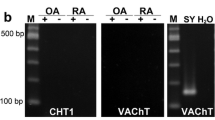Abstract
Degeneration and loss of articular cartilage are the characteristic features of osteoarthritis (OA), with the appearance of fibrillations, cell clusters, matrix depletion, and changes in matrix composition all apparent. Histamine has a recognised role in allergic and inflammatory reactions, and is reported to affect several aspects of chondrocyte behaviour. The immunohistochemical (IHC) studies reported here have demonstrated histamine (H), both H1 and H2 receptors, and the histamine-producing enzyme histidine decarboxylase (HDC) in a variable proportion of human articular chondrocytes in OA cartilage specimens. Such observations were especially evident within the degenerative, superficial zone, and more so in late-stage disease. By contrast, “normal” age-matched cartilage specimens showed relatively little immunopositive staining for histamine and HDC. These findings strongly suggest that histamine and H-receptor expression by HAC in OA cartilage is potentially an important contributor to the atypical, aberrant phenotype of OA chondrocytes.


Similar content being viewed by others
References
Pelletier J-P, Martel-Pelletier J, Abramson SB (2001) Osteoarthritis, an inflammatory disease. Potential implication for the selection of new therapeutic targets. Arthritis Rheum 44:1237–1247
Poole AR (1993) Cartilage in health and disease. In: McCarty DJ, Koopman WJ (eds) Arthritis and allied conditions: a textbook of rheumatology, vol 2, 12th edn. Lea & Febiger, Philadelphia, pp 279–333
Goldring MB (2000) The role of the chondrocyte in osteoarthritis. Arthritis Rheum 43:1916–1926
Freemont AJ, Hampson V, Tilman R, Goupille P, Taiwo Y, Hoyland JA (1997) Gene expression of matrix metalloproteinase 1, 3 and 9 by chondrocytes in osteoarthritic human knee articular cartilage is zone and grade specific. Ann Rheum Dis 56:542–549
Tetlow LC, Adlam DJ, Woolley DE (2001) Matrix metalloproteinases and proinflammatory cytokine production by chondrocytes of human osteoarthritic cartilage. Arthritis Rheum 44:585–594
Laszlo V, Rothe G, Hegyesi H, Szeberenyi JB, Orso E, Schmitz G et al (2001) Increased histidine decarboxylase expression during in vitro monocyte maturation; a possible role of endogenously synthesised histamine in monocyte/macrophage differentiation. Inflamm Res 50(8):428–434
Heninger E, Falus A, Darvas Z, Szalai C, Zsinko M, Pos Z et al (2000) Both interferon (IFN) alpha and IFN gamma inhibit histidine decarboxylase expression in the HT168 human melanoma cell line. Inflamm Res 49(8):393–397
White MV, Kaliner MA (1988) Histamine. In: Gallin JR, Goldstein IM, Snyderman R (eds) Inflammation: basic principles and clinical correlates. Raven Press, New York, pp 169–193
Lagier B, Lebel B, Bousquet J, Pene J (1997) Different modulation by histamine of IL-4 and interferon-gamma (IFN-gamma) release according to the phenotype of human Th0, Th1 and Th2 clones. Clin Exp Immunol 108:545–551
Schneider E, Rolli-Derkinderen M, Arock, Dy M (2002) Trends in histamine research: new functions during immune responses and hematopoiesis. Trends Immunol 23:255–263
Hill SJ, Ganellin CR, Timmerman H, Schwartz JC, Shankley NP, Young JM et al (1997) International Union of Pharmacology. XIII. Classification of histamine receptors. Pharmacol Rev 49:253–278
Malone DG, Irani AM, Schwartz LB, Barrett KE, Metcalfe DD (1986) Mast cell numbers and histamine levels in synovial-fluids from patients with diverse arthritides. Arthritis Rheum 29(8):956–963
Buckley MG, Walters C, Wong WM, Cawley MID, Ren S, Schwartz LB et al (1997) Mast cell activation in arthritis; detection of alpha- and beta-tryptase, histamine and eosinophilic cationic protein in synovial fluid. Clin Sci 93:363–370
Tetlow LC, Woolley DE (2003) Histamine stimulates the proliferation of human articular chondrocytes in vitro and is expressed by chondrocytes in human articular cartilage. Ann Rheum Dis 62:991–994
Tetlow LC, Woolley DE(2002) Histamine stimulates matrix metalloproteinase-3 and −13 production by human articular chondrocytes in vitro. Ann Rheum Dis 61:737–740
Yamauchi K, Sato R, Tanno Y, Ohkawara Y, Maeyama K et al (1990) L-histidine decarboxylase derived from human basophilic leukaemia cell line, KU-812-F. Nucleic Acids Res 18:5891–5898
Igaz P, Falus A (2004) Cytokines, chemokines and histamine. In: Falus A, Grossman N, Darvas Z (eds) Histamine: biology and medical aspects. Karger& Springer Med. Publishing, Budapest Basel, pp 112–118
Lee DM, Friend DS, Gurish MF, Benoist C, Mathis D, Brenner MB (2002) Mast cells: a cellular link between autoantibodies and inflammatory arthritis. Science 297:1689–1692
Taylor DJ, Woolley DE (1987) Evidence for both histamine H-1 and H-2 receptors on human articular chondrocytes. Ann Rheum Dis 46:431–435
Taylor DJ, Yoffe JR, Brown DM, Woolley DE (1986) Histamine stimulates prostaglandin-E production by rheumatoid synovial cells and human articular chondrocytes in culture. Arthritis Rheum 29:160–166
Leurs R, Smit MJ, Timmerman H (1995) Molecular pharmacological aspects of histamine receptors. Pharmacol Ther 66(3):413–463
Priestley JV, Wotherspoon G, Savery D, Acerill S, Rattray M (1993) A combined in-situ hybridisation and immunofluorescence procedure allowing visualisation of peptide messenger-RNA and serotonin in single sections. J Neurosci Method 58(1–2):99–110
Watanabe T, Yamatodani A, Maeyama K, Wada H (1990) Pharmacology of a-fluoromethylhistidine, a specific inhibitor of histidine decarboxylase. TIPS Rev 11:363–366
Acknowledgements
This study was supported by The Health Foundation (formerly The PPP Foundation). The authors would also like to thank orthopaedic surgeons T. Dunningham (Tameside Hospital, Manchester) and D.S. Johnson (Stepping Hill Hospital, Stockport) for the supply of joint tissues. Preliminary findings of histamine and HDC expression by chondrocytes was presented at the European Histamine Research Society meeting, Noordwijkerhout, May 2003, with proceedings published in Inflamm Res (2004) 53(Suppl 1):S21–S22.
Author information
Authors and Affiliations
Corresponding author
Rights and permissions
About this article
Cite this article
Tetlow, L.C., Woolley, D.E. Histamine, histamine receptors (H1 and H2), and histidine decarboxylase expression by chondrocytes of osteoarthritic cartilage: an immunohistochemical study. Rheumatol Int 26, 173–178 (2005). https://doi.org/10.1007/s00296-005-0622-x
Received:
Accepted:
Published:
Issue Date:
DOI: https://doi.org/10.1007/s00296-005-0622-x




